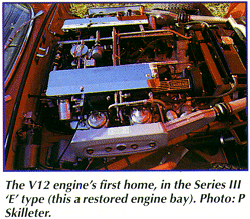|
|
 |
[ Main ] [ 1 ] [ 2 ]
[ 3 ] [ 4 ] [ 5 ] [ 6 ] [ 7 ] [ 8 ] [ 9 ] [ 10 ] [ 11 ] |
|
Returning for the moment to the twin cam V12, it simultaneously followed 2
development paths, one for the all-out racer and the other towards a more
refined and gentle creature for a production car. The noisy partly geared
cam drive of the high revving racer became a multiple chain drive: moderate
cams and port sizes sacrificed power for drivability: multiple stack Lucas
fuel injection was replaced by 6 SU carbs. Yet still it was not good
enough, quite apart from being bulky and heavy. Now shortly before this
time Coventry Climax, by then a subsidiary of Jaguar, had introduced a
range of industrial engines which used a simple flat OHC cylinder head
design with bowl in piston combustion chambers. Under the legendary Walter
Hassan, Climax had found that this layout provided a very good balance of
performance, economy and detonation resistance, and was compact and easy to
manufacture. It was not long before it was realised that here could be the
answer to the road going V12s problems - simple and compact cylinder heads
with single camshafts, a simplified cam drive needing only one chain, and a
substantial weight saving. Single cylinder test bed work showed that
performance would be more than adequate, in fact, mid-range performance was
better than the twin cam so the day came when V12s of both types were
fitted into Mk10 saloons and compared on the road. It was no contest really
and only the aura of the twin cam remained - but not for long.
This was a very significant point in the genesis of the V12 and one which is somewhat puzzling. The bad experience which prompted Keith Duckworth to arrive at the DFV design had been with his own Formula 2 SCA engine from 1964 - a flat head, single cam design with bowl in piston combustion chambers. Whilst it performed well enough to win a lot of races it always had a fundamental combustion problem and needed a lot of ignition advance to work properly, just as the twin cam V12 did. Certainly Duckworth was amazed to hear that Jaguar intended to proceed with the V12 as a flat head engine. Perhaps the conclusions reached by Climax were because of a fortunate combination of bore and stroke, valve sizes or whatever, but the usage pattern of an industrial engine may also be significant, spending long periods at about 75% load, rather than full load as in a race engine, or mostly light load as in a road car. It is not a criticism of Walter Hassan, who by now was deeply involved with the V12, or any of his team to point out this quandary. In his 1972 paper to the SAE Hassan admitted that at that time the knowledge of what happened to the charge in the cylinder of the flat head V12 was very much open to conjecture and that charge turbulence may well stagnate in some conditions. Nevertheless there can be no doubt that the flat head V12 (Fig. 2) was a very much more practical proposition than the twin cam version ever was. In arriving at this point a great deal of experimental work had been done with different port layouts and spark plug locations but gradually the design evolved into the final cross-flow layout with a steeply inclined inlet port which remained to the end. Compression ratio was originally intended to be 10:1 for production, even 10.6:1 being considered for a time, but impending emission legislation and the disappearance of 5 star fuel decreed a change to 9:1 for European markets and a miserable 7.8:1 for 91 octane lead free fuel in the USA. Those who experienced driving them always maintained that the original 10:1 EFI engines were the best by far, but it was not until 1980 that such an engine was actually on sale for about a year prior to the arrival of the HE. The original 3.4 litre version of the XK was always regarded as the best of the line and the same can be said of the rather rare 10:1 V12 rated at 300 b.h.p. |

|
| [ Main ] [ 1 ] [ 2 ] [ 3 ] [ 4 ] [ 5 ] [ 6 ] [ 7 ] [ 8 ] [ 9 ] [ 10 ] [ 11 ] |
Email aj6engineering@ntlworld.com, Tel/Fax:- 0044 (0)1625 573556 |


